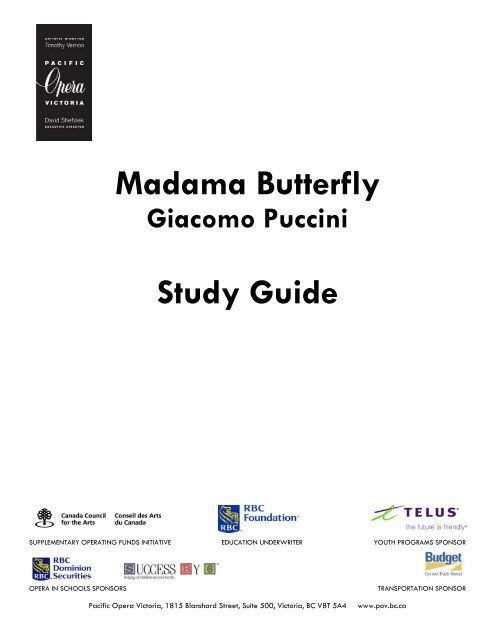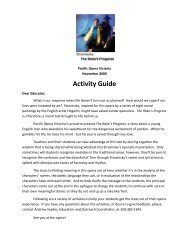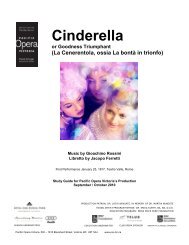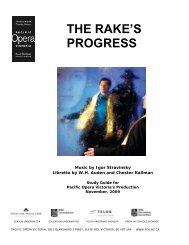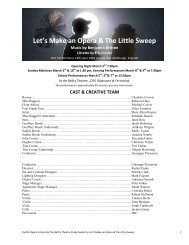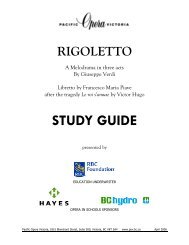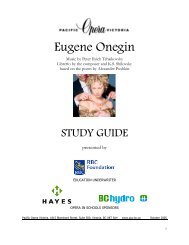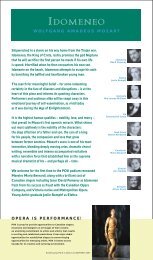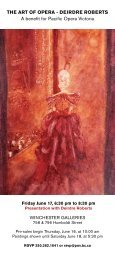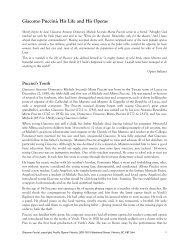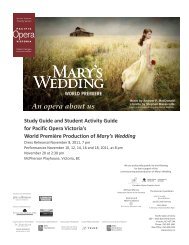Madama Butterfly Study Guide - Pacific Opera Victoria
Madama Butterfly Study Guide - Pacific Opera Victoria
Madama Butterfly Study Guide - Pacific Opera Victoria
You also want an ePaper? Increase the reach of your titles
YUMPU automatically turns print PDFs into web optimized ePapers that Google loves.
<strong>Madama</strong> <strong>Butterfly</strong><br />
Giacomo Puccini<br />
<strong>Study</strong> <strong>Guide</strong><br />
SUPPLEMENTARY OPERATING FUNDS INITIATIVE EDUCATION UNDERWRITER YOUTH PROGRAMS SPONSOR<br />
OPERA IN SCHOOLS SPONSORS<br />
<strong>Pacific</strong> <strong>Opera</strong> <strong>Victoria</strong>, 1815 Blanshard Street, Suite 500, <strong>Victoria</strong>, BC V8T 5A4<br />
TRANSPORTATION SPONSOR<br />
www.pov.bc.ca
Welcome to <strong>Pacific</strong> <strong>Opera</strong> <strong>Victoria</strong>!<br />
This <strong>Study</strong> <strong>Guide</strong> has been created primarily to assist teachers in preparing students for<br />
their visit to the opera. It is our hope that teachers will be able to add this to the<br />
existing curriculum in order to expand students’ understanding of opera, literature,<br />
history, and the fine arts.<br />
Materials in the <strong>Study</strong> <strong>Guide</strong> may be copied and distributed to students. Some students<br />
may wish to go over the information at home if there is not enough time to discuss in<br />
class. The opera experience can be made more meaningful and enjoyable when<br />
students have the opportunity to learn about the opera before they attend the<br />
performance.<br />
For more information about the history of opera, including a glossary of opera terms, please see other<br />
<strong>Study</strong> <strong>Guide</strong>s on the <strong>Pacific</strong> <strong>Opera</strong> <strong>Victoria</strong> web site at http://www.pov.bc.ca/involve_education.html .<br />
Teachers: Your comments and suggestions would be greatly appreciated. Please take a few minutes to<br />
fill out the questionnaire at the end of this study guide.<br />
Please Note: The Dress Rehearsal is the last opportunity the singers will have on stage to work with the<br />
orchestra before Opening Night. Since vocal demands are so great on opera singers, some singers choose<br />
not to sing in full voice during the Dress Rehearsal in order to preserve their voice for opening night.<br />
Contents<br />
Welcome to <strong>Pacific</strong> <strong>Opera</strong> <strong>Victoria</strong>! _____________________________________________ 1<br />
Cast List _________________________________________________________________ 2<br />
Message from the Artistic Director _____________________________________________ 3<br />
Synopsis of the <strong>Opera</strong> ______________________________________________________ 4<br />
From Verismo to Turandot – A Puccini Primer ____________________________________ 5<br />
The Personality of Giacomo Puccini_____________________________________________ 6<br />
From Tabloid to <strong>Opera</strong>: The Genesis of <strong>Butterfly</strong>’s Story ____________________________ 7<br />
<strong>Butterfly</strong>’s Music: Giving a Voice to Hope ________________________________________ 8<br />
Puccini and Japonisme ______________________________________________________ 11<br />
<strong>Butterfly</strong> Stories ___________________________________________________________ 13<br />
Japanese Phrases in the Libretto_______________________________________________ 15<br />
About POV’s Production______________________________________________________ 16<br />
<strong>Study</strong> Activities ____________________________________________________________ 17<br />
Teacher’s Comments________________________________________________________ 22<br />
________________________________________________________________________________________________________<br />
<strong>Pacific</strong> <strong>Opera</strong> <strong>Victoria</strong> <strong>Study</strong> <strong>Guide</strong> for <strong>Madama</strong> <strong>Butterfly</strong> 2008 1
MADAMA BUTTERFLY<br />
Dress Rehearsal February 12, 2008<br />
February 14, 16, 19, 21, 23, 2008, 8 pm<br />
Royal Theatre, <strong>Victoria</strong>, BC<br />
Music by Giacomo Puccini<br />
Libretto by Luigi Illica and Giuseppe Giacosa<br />
First Performance La Scala, Milan, February 17, 1904<br />
Sung in Italian with English surtitles<br />
CAST & CREATIVE TEAM<br />
Cast in order of vocal appearance<br />
Lieutenant Benjamin Franklin Pinkerton<br />
Goro, a marriage broker<br />
Suzuki<br />
Sharpless, United States consul at Nagasaki<br />
<strong>Madama</strong> <strong>Butterfly</strong> (Cio-Cio-San)<br />
The Imperial Commissioner<br />
The Registrar<br />
The Bonze, Cio-Cio-San's uncle<br />
Prince Yamadori<br />
Kate Pinkerton<br />
Trouble, Cio-Cio-San’s child<br />
Conductor<br />
Director<br />
Designer<br />
Lighting Designer<br />
Resident Stage Manager<br />
Assistant Stage Managers<br />
Chorus Master and Répétiteur<br />
Kurt Lehmann<br />
Eric Olsen<br />
Michèle Losier<br />
Bruce Kelly<br />
Sally Dibblee<br />
Stephen Barradell<br />
Robyn Cathcart<br />
Chad Louwerse<br />
Peter McGillivray<br />
Stacie Carmona<br />
Trinity Startek<br />
Giuseppe Pietraroia<br />
François Racine<br />
Elli Bunton<br />
Gerald King<br />
Jackie Adamthwaite<br />
Steve Barker<br />
Connie Hosie<br />
Michael Drislane<br />
With the <strong>Victoria</strong> Symphony and the <strong>Pacific</strong> <strong>Opera</strong> <strong>Victoria</strong> Chorus<br />
Cast and programme are subject to change.<br />
PRODUCTION SPONSORS<br />
________________________________________________________________________________________________________<br />
<strong>Pacific</strong> <strong>Opera</strong> <strong>Victoria</strong> <strong>Study</strong> <strong>Guide</strong> for <strong>Madama</strong> <strong>Butterfly</strong> 2008 2
Message from the Artistic Director<br />
Like the other most popular opera in the world – Carmen – <strong>Madama</strong> <strong>Butterfly</strong> was a fiasco on its<br />
opening night. The soprano was visibly pregnant (a rumour had been spread that the conductor –<br />
Toscanini – was the father); an anti-Puccini clique, fuelled by jealousy and resentment of the<br />
composer’s successes, was prepared to disrupt things at every turn with boos and catcalls….it was a<br />
humiliating evening. Puccini withdrew the score for revision, and at least, unlike poor Bizet, lived to<br />
see his opera eventually become a universal favourite.<br />
An aspect of Puccini’s genius which has always fascinated me is his astonishing ability, using much<br />
the same orchestra, in each of his mature works to create, to conjure, a specific, musically-induced<br />
atmosphere. If Bohème includes some real gaîeté parisienne, if in Tosca we catch a whiff of old<br />
incense in the dark of the stony cathedral, with <strong>Madama</strong> <strong>Butterfly</strong> we are transported to a place at<br />
once familiar and strange. The folk song “Sakura”, together with other fragments and echoes, as a<br />
sort of objet trouvé puts Japanese music right in the foreground. But the delicate web of melodic<br />
contours and above all the harmonies (augmented triads pervasive here) and gentle touches of harp<br />
and percussion maintain a sense of “otherness” – almost an exotic perfume. Puccini’s control of the<br />
minutest details in his scores impresses those who admire craftsmanship (Anton von Webern was a<br />
big fan), and his lyric inspiration, providing wave after wave of gorgeously grateful singing lines, is<br />
at its peak. He entrusted a friend, Panizza, to prepare a reduction of the large romantic orchestration<br />
for smaller theatres. This was accomplished with sensitivity and to the composer’s satisfaction, and is<br />
the version we use with this production.<br />
It is our fourth presentation of this masterpiece. Our goal is to rediscover the many beauties and<br />
ambiguities in the piece: to avoid a clichéd, “touristic” treatment of its setting, yet to suggest its<br />
enchantment; to show the harsh realities of the central relationship, yet to allow you to decide on the<br />
moral framework within which you experience the events.<br />
Many great soprano names are associated with the title role. We present with honour and delight<br />
Sally Dibblee in her debut performances. Those who remember her first Violettas from a few seasons<br />
ago know to expect something very special. Kurt Lehmann (Pinkerton) and Bruce Kelly (Sharpless)<br />
are great and always welcome friends of POV. We introduce with pride our resident artists in<br />
important supporting roles.<br />
François Racine, who returns to direct, has grown over the many years of our collaboration into a<br />
true master. Our very young designer, Elli Bunton, has in her POV debut met a great challenge with<br />
resourcefulness and marvellous invention. We welcome back to the podium our very own Maestro<br />
Giuseppe Pietraroia.<br />
I hope your experience this evening will encourage you to book seats for the last production of our<br />
season – a Canadian premiere: Mark Blitzstein’s Regina, based on Lillian Hellman’s play The Little<br />
Foxes. Meanwhile, I wish you as always a great night with us in the theatre!<br />
________________________________________________________________________________________________________<br />
<strong>Pacific</strong> <strong>Opera</strong> <strong>Victoria</strong> <strong>Study</strong> <strong>Guide</strong> for <strong>Madama</strong> <strong>Butterfly</strong> 2008 3
Synopsis<br />
Act 1<br />
In 1904, Benjamin Franklin Pinkerton, an American naval officer posted in Nagasaki, Japan,<br />
arranges with the marriage broker Goro to lease a house – along with a pretty young wife. Both deals<br />
may be cancelled on a month’s notice. The American consul, Sharpless, warns Pinkerton that the girl<br />
may not take such a casual view of this marriage. Pinkerton is unconcerned; for now he is entranced<br />
by the girl nicknamed <strong>Butterfly</strong> – but he drinks to the day he will wed “in real marriage a real<br />
American wife.”<br />
The girl, Cio-Cio-San, is an innocent, trusting 15-year-old, who has had to earn her living as a geisha<br />
after her father committed suicide by order of the Mikado. Already passionately in love with<br />
Pinkerton, <strong>Butterfly</strong> is ecstatic as she arrives for the wedding. After the brief ceremony, her uncle,<br />
the Bonze, interrupts the festivities and denounces Cio-Cio-San for renouncing her religion and<br />
turning to Christianity. Her family join the Bonze in condemning and shunning the devastated girl.<br />
Pinkerton comforts <strong>Butterfly</strong>, and they sing a love duet in their new home.<br />
Intermission<br />
Act 2<br />
Three years later, <strong>Butterfly</strong> is living alone with her servant Suzuki and the child that <strong>Butterfly</strong> bore<br />
after Pinkerton’s return to the US. The two women are nearly out of money, and Suzuki doubts that<br />
Pinkerton will ever come back. <strong>Butterfly</strong>, however, believes with steely resolve that she, her<br />
husband, and their baby will be together one day.<br />
Goro has been presenting a succession of suitors to <strong>Butterfly</strong>; the latest is Prince Yamadori, but<br />
<strong>Butterfly</strong> insists she is still married to Pinkerton and will not consider his offer.<br />
When Sharpless brings <strong>Butterfly</strong> a letter from Pinkerton, he doesn’t have the courage to read it to her.<br />
Instead he asks what she would do were Pinkerton never to return. <strong>Butterfly</strong> tells him she would have<br />
but two choices – to go back to the life of a geisha or to die. Sharpless advises her to accept Prince<br />
Yamadori’s offer of marriage. <strong>Butterfly</strong> is horrified, and then triumphant as she shows Sharpless her<br />
son, Trouble, who will be renamed Joy on his father’s return. Sharpless leaves, promising to tell<br />
Pinkerton about the child.<br />
Pinkerton’s ship, the Abraham Lincoln, arrives in the harbour, and <strong>Butterfly</strong> joyfully decorates the<br />
house with flowers, then keeps vigil through the night, awaiting Pinkerton.<br />
Act 3<br />
Early the next morning Sharpless arrives with Pinkerton and his new American wife, Kate. They<br />
want <strong>Butterfly</strong> to give them the child and try to persuade Suzuki to break the news to her. Guiltridden,<br />
Pinkerton cannot bear to face <strong>Butterfly</strong> and flees the scene. As soon as she sees Kate,<br />
<strong>Butterfly</strong> understands the situation. She agrees to give up the child, but only if Pinkerton comes in<br />
person to fetch him. Kate and Sharpless go to find Pinkerton. <strong>Butterfly</strong> embraces the child, sends him<br />
away to play, and then, like her father before her, kills herself — as Pinkerton rushes in, calling her<br />
name.<br />
________________________________________________________________________________________________________<br />
<strong>Pacific</strong> <strong>Opera</strong> <strong>Victoria</strong> <strong>Study</strong> <strong>Guide</strong> for <strong>Madama</strong> <strong>Butterfly</strong> 2008 4
From Verismo to Turandot – A Puccini Primer<br />
In the late 1900’s, a literary movement arose that came to be known as verismo (from the Italian<br />
word vero, or truth). The verismo writers steeped their stories in human passion rather than reason,<br />
and created white-hot tales of love, jealousy, revenge and violence. Giuseppe Verga, author of<br />
Cavalleria Rusticana from a selection of short stories Vita dei campi (Life in the Fields), and Luigi<br />
Capuana were the leading proponents.<br />
Their stories proved great source material for a new age of Italian composers, searching for a post-<br />
Verdid voice that could capture the social tensions of fin-de siecle Europe. The first successful<br />
operas in this style, Pietro Mascagni’s Cavalleria Rusticana and Ruggero Leoncavallo’s I Pagliacci,<br />
were dramaturgically based on compression. Based on short stories, these hour long operas were<br />
created in reaction to the lengthening of the form during the late Romantic period. Characters were<br />
drawn in bold primary colours. Arias were shorter, and rather than memorable tunes and rhyming<br />
poetry, they offered rich, sweeping melodies based on narrative text. Plots were based on a few<br />
incidents that took place during a short period of time. The endings of each opera had the qualities of<br />
“grand guignol”, a populist French theatrical counterpart.<br />
Puccini’s first operas, Le Villi and Edgar, were very much in this style. Le Villi is an operatic telling<br />
of the story of the ballet Giselle, which presents the story of the forest spirits of jilted brides, who<br />
haunt and eventually kill false lovers. Edgar ends with the murder of the leading lady at the hands of<br />
her evil rival for the title character’s affections. Both operas showed veristic promise, but were not<br />
ultimately lasting.<br />
With Manon Lescaut, Puccini began to establish a more complete version of verismo, rich with the<br />
passion of the previous decade, but fuller in characterization and musical development. La Bohème<br />
embraces the verismo value of celebrating the real lives of everyday people, created with a softer<br />
musical voice. Tosca followed, with a return to the grand and gruesome passions of the earlier<br />
operas.<br />
With <strong>Madama</strong> <strong>Butterfly</strong>, Puccini found a balance between the sentimental and the overwhelming.<br />
Great moments of delicacy alternate with emotional outpourings that well from the emotional core of<br />
the characters. The villainy is one of Pinkerton’s carelessness rather than a malevolence, <strong>Butterfly</strong>’s<br />
tragedy is one of misplaced hope rather than blind jealousy or fatal illness. The conflict is both<br />
personal and cultural, a story of larger scope than the private stories of the earlier operas.<br />
After <strong>Butterfly</strong>, Puccini began a period of experimentation with each opera different from the next.<br />
La Rondine was Puccini’s attempt at writing in the operetta style. With rapturous waltzes and an<br />
ending marked by the end of a relationship rather than a life, La Rondine is perhaps Puccini’s most<br />
sentimental work. In La Fanciulla del West, Puccini created an impressionistic landscape of the<br />
America of legend, equal parts Debussy and stories of the West. The operas of Il Trittico (Il<br />
Tabarro, Suor Angelica, and Gianni Schicci) highlight different aspects of Puccini’s personality:<br />
passionate, spiritual, and fun-loving. His final opera Turandot, his most musically adventurous, was<br />
more a precursor to the future than a celebration of the past.<br />
For more information on Puccini’s life, visit www.pov.bc.ca/pdfs/Puccini.pdf<br />
________________________________________________________________________________________________________<br />
<strong>Pacific</strong> <strong>Opera</strong> <strong>Victoria</strong> <strong>Study</strong> <strong>Guide</strong> for <strong>Madama</strong> <strong>Butterfly</strong> 2008 5
The Personality of Giacomo Puccini<br />
Giacomo Puccini was a man of many contradictions. He was at once the fun-loving man of the<br />
theatre and life of the party and a melancholic artist whose personal relationships were filled<br />
with pain and longing. Two examples from his writings illustrate this dichotomy.<br />
The Rules of Le Club de la Bohème<br />
1. The members of the Club la bohème, faithful interpreters of the spirit in which it was<br />
founded, pledge themselves under oath to be well and eat better.<br />
2. Grouches, pedants, weak stomachs, fools grumblers and other wretches of this kind will<br />
not be admitted but will be chased away by the members.<br />
3. The president functions as conciliator in disputes, but pledges himself to hinder the<br />
treasurer in the collection of the members.<br />
4. The treasurer is empowered to abscond with the funds.<br />
5. The illuminations of the club-room shall be by means of a paraffin lamp. Should there be<br />
a shortage of paraffin, the moccoli of the members will be used (A pun, the word means<br />
both candle-ends and oaths.)<br />
6. It is forbidden to play cards honestly.<br />
7. Silence is prohibited.<br />
8. Wisdom is not permitted, except in special cases.<br />
The Poetry<br />
I feel alone, without a friend,<br />
Even music makes me sad.<br />
When death shall come to find me<br />
I shall be glad to rest.<br />
Oh how hard is my life,<br />
though I seem happy to many.<br />
But what of my successes?<br />
They pass and what remains?<br />
It’s worth so little –<br />
they are ephemeral things,<br />
Life runs on towards the abyss.<br />
Those who are alive and young are happy,<br />
but who is aware of all this?<br />
One’s youth passes quickly,<br />
and the eye scrutinizes eternity.<br />
Throughout his life these emotional poles were at play with one another, and can be heard in the<br />
romance, wit, and melancholy of his music.<br />
________________________________________________________________________________________________________<br />
<strong>Pacific</strong> <strong>Opera</strong> <strong>Victoria</strong> <strong>Study</strong> <strong>Guide</strong> for <strong>Madama</strong> <strong>Butterfly</strong> 2008 6
From Tabloid to <strong>Opera</strong>: The Genesis of <strong>Butterfly</strong>’s Story<br />
The road to the creation of Puccini’s <strong>Madama</strong> <strong>Butterfly</strong> begins with a reportedly true story, and<br />
continues through a series of re-tellings to become one of operas iconic works.<br />
The story began as a true account of the life of Tsuru Yamamura, a Japanese woman who had a son<br />
with an English merchant. Abandoned, she attempted suicide, and ultimately the child was taken not<br />
to America, but to Nagasaki.<br />
John Luther Long, an American lawyer, romanticized and inflated the story and published it as an<br />
article in Century Magazine in 1898. His story is very close to <strong>Madama</strong> <strong>Butterfly</strong>, save the fact that<br />
<strong>Butterfly</strong>’s suicide is not successful, and she disappears with the child rather than allow him to be<br />
taken by his father.<br />
His story was undoubtedly influenced by the 1887 faux memoir Madame Chysanthème by French<br />
naval officer Pierre Loti. Loti takes a far less kind view of his Japanese geisha, who is interested<br />
only in the riches she can extract from him, and the final scene shows Chrysanthème counting her<br />
money and waiting for her next “husband”.<br />
Felix Regamey, outraged at the tone of the novel, wrote the reactionary novel in 1894, Le cahier rose<br />
de Mme Chrysansthème, a sympathetic reaction told from geisha’s perspective.<br />
These stories, and many like them, were at the forefront of popular culture. David Belasco, an<br />
American playwright and producer, was inspired to write a one act play in 1900 as a companion<br />
piece to a farce Naughty Anthony. In Belasco’s version, the play begins with the abandoned<br />
<strong>Butterfly</strong> of Act II, and three elements, <strong>Butterfly</strong>’s silent vigil, her ultimate suicide and Pinkerton’s<br />
delayed return were added by Belasco to build the dramatic thrust of the piece.<br />
Puccini, who saw the play performed in English and could scarcely understand the dialogue, was<br />
intensely moved by the arch of the story. In the hands of his librettists Giuseppe Giacosa and Luigi<br />
Illica, the events of Act I were created, as well as text far more poetic than Belasco’s sensational<br />
drama. At one point during the exploration of libretto, Illica had created an additional act set in the<br />
consulate, but Puccini demanded its omission, insisting that “the drama must close without<br />
interruption – rapid, effective, horrible.”<br />
Ultimately, the story, realized in so many ways, found its most sensitive home in Puccini’s opera,<br />
imperfect in its Japanese references perhaps, but most certainly true to the tragic events that befell the<br />
original characters.<br />
________________________________________________________________________________________________________<br />
<strong>Pacific</strong> <strong>Opera</strong> <strong>Victoria</strong> <strong>Study</strong> <strong>Guide</strong> for <strong>Madama</strong> <strong>Butterfly</strong> 2008 7
<strong>Butterfly</strong>’s Music: Giving a Voice to Hope<br />
<strong>Madama</strong> <strong>Butterfly</strong> is one of opera’s most accessible works, built on beautiful, evocative melodies and<br />
a heartfelt, compelling story, all amidst a backdrop of social conflict that remains relevant a century<br />
after its premiere. Suprisingly, the work has been reviled by critics and summarily dismissed by<br />
musicologists. Even the composer’s friend Guilio Ricordi noted the piece as a “facile tear-jerker”<br />
unworthy of Puccini’s genius.<br />
In recent years, however, the work’s profound popularity has inspired writers and musicians to<br />
engage in new critical review, and Puccini’s self-professed favourite opera appears to have gained a<br />
new artistic respect to match its sentimental appeal. The often underestimated composer is being<br />
recognized as an artful interpreter of text, an inspired orchestrator, and of course, a master melodist,<br />
one who can weave these skills to create character and drama that can speak directly to the heart of<br />
his listener.<br />
As you explore <strong>Madama</strong> <strong>Butterfly</strong> – for the first or 20 th time – consider these musical aspects of the<br />
work that underlie the truly sumptuous and expansively emotional score.<br />
Melodic Cells<br />
Melody in <strong>Madama</strong> <strong>Butterfly</strong> is paramount; character is defined by consistent use of particular<br />
intervallic patterns – short, melodic cells, if you like - that are repeated, embellished, and developed<br />
to create unity of character throughout the work.<br />
For example, listen for the first two bars music of <strong>Butterfly</strong>’s entrance; these four notes form the<br />
basis for the aria that announces the entrance of the innocent heroine.<br />
Example #1 – <strong>Butterfly</strong>’s Entrance<br />
Five upwardly modulating repetitions of this theme, taken by solo violin, woodwinds, solo voice and<br />
ultimately full orchestra evolve into a full statement of the aria’s melody, an aural impression of a<br />
flower coming into blossom, petal by petal. Later in the act, this same melody reappears several<br />
times, notably as the final climax of <strong>Butterfly</strong> and Pinkerton’s Love Duet (Dolce notte! Quante<br />
Stelle! – Sweet Night! So many Stars!), while the opera’s most popular aria, (Un bel di vedremo)<br />
evolves from this same two measure melodic cell.<br />
For all the impressionist sounds of <strong>Butterfly</strong>’s music, Pinkerton’s music takes a decidedly more<br />
forthright tone. His first aria is built on the opening notes of “The Star Spangled Banner”, a perfect<br />
major triad, evoking not only the familiar patriotic sounds of the American National Anthem, but<br />
also a simplicity and clarity far removed from the impressionist chromatic planning of <strong>Butterfly</strong>’s<br />
entrance music. It is most certainly no coincidence that Pinkerton’s second aria (Amore o grillo, dir<br />
non saprei – I cannot say whether it is love or caprice), where he tells the consul Sharpless of the<br />
superficial quality of his feelings for <strong>Butterfly</strong>, begins with this same major triad, and his solo music<br />
shares the same directness of melodic/design throughout.<br />
________________________________________________________________________________________________________<br />
<strong>Pacific</strong> <strong>Opera</strong> <strong>Victoria</strong> <strong>Study</strong> <strong>Guide</strong> for <strong>Madama</strong> <strong>Butterfly</strong> 2008 8
Repetition<br />
Sustained repetition of musical ideas can create cathartic moments; emotion is intensified as the<br />
listener hears the relentless repetition as a tragic scene unfolds. This technique is not specific to any<br />
particular time period; it can be heard in the final laments of Monteverdi and Purcell and in the<br />
minimal music of Phillip Glass. Puccini is a master of this technique and employed it throughout his<br />
canon; it can be scene in the Embarkation Scene in Manon Lescaut, the execution of Cavaradossi in<br />
Tosca, and the Calaf’s obsessive infatuation with Turandot at that ends Act I.<br />
In Act II, repetition creates wrenching despair as we watch the American consul reveal to <strong>Butterfly</strong><br />
the contents of the letter from Pinkerton: he will not be returning. At the start of the scene, the<br />
following ostinato (repetitive theme) is introduced:<br />
Example #2 – Letter Duet from Act II<br />
The consistent repetition of this theme, developed with a series of countermelodies, can be seen to<br />
represent <strong>Butterfly</strong>’s single-minded belief and blinding hope that he will return. The audience, of<br />
course, knows that this will not happen, but as Puccini spins out this musical scene, minute after<br />
minute, the emotional power of her false hope becomes unbearable to watch. These same themes<br />
become the basis for the “Humming Chorus”, the quiet music that accompanies the start of <strong>Butterfly</strong>,<br />
Suzuki and the child Trouble’s vigil upon hearing the sound of Pinkerton’s ship in the harbour. By<br />
adding the sound of the human voice to the offstage, it is as if we ourselves have joined the story as<br />
witness to the heroine’s soon to be broken dreams.<br />
Exotic Elements<br />
The “exotic” sounds incorporated into the score are more readily heard. In preparation to compose<br />
<strong>Butterfly</strong>, Puccini studied Japanese folk music and included a wide range of melodies learned<br />
through this study. While still very much in the Italian tradition, this Japanese style and at times the<br />
melodies themselves are incorporated throughout the score. The clipped staccato narrative of the<br />
marriage broker Goro creates a studied Japanese character, pentatonic scales evoke the sounds of folk<br />
tunes at <strong>Butterfly</strong>’s wedding, repeated crashes of the gong herald the Bonze’s condemnation of<br />
<strong>Butterfly</strong>’s marriage outside the faith, and Suzuki’s Act II prayer to the gods is based on an Eastern<br />
chant.<br />
Takai-Yama, traditional Japanese melody, heard in Act II Scene I, Suzuki’s Prayer<br />
A full listing of the Japanese melodies found in <strong>Madama</strong> <strong>Butterfly</strong> can be found at<br />
http://daisyfield.com/music/jpm/Puccini.htm<br />
________________________________________________________________________________________________________<br />
<strong>Pacific</strong> <strong>Opera</strong> <strong>Victoria</strong> <strong>Study</strong> <strong>Guide</strong> for <strong>Madama</strong> <strong>Butterfly</strong> 2008 9
Orchestration<br />
While melody provides the framework for consistent character development, it is the orchestration<br />
that creates the intensity of emotion that makes this work so compelling.<br />
When listening to “Un bel di vedremo”, Puccini’s mastery in this arena is evident. Solo violin and<br />
muted strings mirror the opening vocal phrases where <strong>Butterfly</strong> begins to paint the picture of her<br />
lover’s return. Low strings and winds take the lead when the ship appears, horns take the melody as<br />
she hears the guns saluting his arrival. As she timidly decides to wait for him at the top of the hill<br />
rather than running to the harbour, the orchestration thins out, and her melody is no longer doubled.<br />
The next section, where <strong>Butterfly</strong> sees the lone figure of Pinkerton emerge from the crowd, is lightly<br />
underscored with strings, this time anticipating the beat and creating dramatic tension as she yearns<br />
for his embrace. The orchestra lightens as she decides again not to answer his cries, “partly for fun<br />
and partly as not to die at their meeting”. On the word “morire”, the melody returns with full strings,<br />
horn and trumpet – a momentary outburst that quiets as she hears Pinkerton call out his pet names for<br />
her. She soon breaks the story to tell Suzuki “all this will happen, I promise you. Keep your fears to<br />
yourself, I shall await him with unspeakable faith”. With this return to reality, Puccini unleashes the<br />
full power of the orchestra, a wellspring of sound that is <strong>Butterfly</strong>’s personal strength and undying<br />
belief. The quiet fifteen year old geisha is called upon to dominate this massive orchestral sound<br />
with a vocal, dramatic and spiritual intensity that is the power of this work.<br />
These are but a few of the examples that illustrate the creative brilliance of Puccini’s music. Every<br />
note in the score, vocal and instrumental, is carefully chosen to create an emotional impact that is<br />
instantly understood, whether it is being heard for the first or hundredth time by a musical novice or<br />
seasoned professional. On the 100 th anniversary of this beloved work, enjoy Puccini’s compositional<br />
mastery that can fill your heart, captivate your mind, and move your soul.<br />
________________________________________________________________________________________________________<br />
<strong>Pacific</strong> <strong>Opera</strong> <strong>Victoria</strong> <strong>Study</strong> <strong>Guide</strong> for <strong>Madama</strong> <strong>Butterfly</strong> 2008 10
Puccini and Japonisme<br />
Puccini called <strong>Madama</strong> <strong>Butterfly</strong> a “tragedia giapponese”: a Japanese tragedy. But it’s an Italian<br />
opera written by three men who had never visited Japan. How Japanese could it really be? And why<br />
write an opera set in Japan in the first place?<br />
The answer to the last question is the French word Japonisme—to translate it literally as Japanism<br />
isn’t sufficient. Better to call it Japanamania. Soon after Japan ended its 200-year isolation from the<br />
West in 1854, the European art world discovered Japan. Western artists admired and imitated the<br />
incredible energy and authenticity of the images, the flat, colored backgrounds, the cutting off of<br />
figures at the edge of a frame, the asymmetry and diagonal constructions, and the juxtaposition of<br />
wildly-colored fabrics in many-layered kimono.<br />
But what brought “the Orient” to the general public were the world’s fairs held in Paris during the<br />
19th century. National pavilions displayed the art and culture of Asia and the <strong>Pacific</strong>, including<br />
plays, poetry, and musical performances. The Expositions of 1867 and 1889 were especially<br />
important to composers, who heard Asian music for the first time and were exposed to a completely<br />
new and stimulating sound world. The five-note scale of Japan (easily played by using just the black<br />
keys on the piano), the complex rhythms of Japanese music, and a whole new world of percussion<br />
instruments found their way into piano pieces, orchestral works, and operas. Gilbert and Sullivan’s<br />
Mikado was written to satirize England’s Japanamania, spurred by the enormously popular Japanese<br />
village on view in London in 1885.<br />
There were other “Japanese” operas, all known to Puccini, before <strong>Madama</strong> <strong>Butterfly</strong>, too: La princess<br />
jaune by Saint-Saëns (1872), Mascagni’s Iris (1898) on a libretto by Luigi Illica, Puccini’s<br />
collaborator; and Messager’s Madame Chrysanthème (1893), one of the original sources of the<br />
<strong>Butterfly</strong> story. So surrounded by Japanamania on every side, the composer was primed for the<br />
encounter with his favorite character, <strong>Madama</strong> <strong>Butterfly</strong>.<br />
“There is no comparison between my love for Mimì, Musetta, Manon, and Tosca and that<br />
love which I have in my heart for her for whom I wrote music in the night.” –Giacomo<br />
Puccini<br />
It was while he was in London to supervise Tosca in 1900 that Puccini fell in love with the heroine of<br />
David Belasco’s melodrama Madame <strong>Butterfly</strong>. Afire with enthusiasm, he directed Giulio Ricordi to<br />
get the rights to Belasco’s play and John Luther Long’s story on which the play was based. While<br />
Puccini was engaged in an intense battle over the plot with his librettists Luigi Illica and Giuseppe<br />
Giacosa, he was also steeping himself in the music and culture of Japan.<br />
In 1902 Puccini met in Milan with Sadayakko, the celebrated actress. He wanted to hear “the high<br />
twitter” of a Japanese woman’s voice, and probably also saw her play, The Geisha and the Knight,<br />
which has a cherry blossom scene much like the flower scene in his opera. Mrs. Oyama, wife of the<br />
Japanese ambassador to Italy, was also invaluable in singing “native” songs to Puccini who wrote<br />
them down and asked many questions. She procured sheet music from Japan and went through the<br />
libretto with the composer, pointing out errors in the names of characters, gods, and household<br />
objects. One mistake she noted was that “Yamadori” is a woman’s name. It remains uncorrected!<br />
Puccini’s hunger for authenticity led him to weave versions of 11 Japanese songs throughout the<br />
score. Besides infusing the music with local color, Puccini used them for their dramatic effect. The<br />
________________________________________________________________________________________________________<br />
<strong>Pacific</strong> <strong>Opera</strong> <strong>Victoria</strong> <strong>Study</strong> <strong>Guide</strong> for <strong>Madama</strong> <strong>Butterfly</strong> 2008 11
original words to the songs didn’t seem to matter. For example, one of the most searing moments of<br />
the score is <strong>Butterfly</strong>’s aria “Che tua madre,” in which she describes life on the streets. Here Puccini<br />
excerpts a traditional rice-planting song. Scholars can’t agree on how many songs Puccini quoted—<br />
there may be more than the 11 substantiated. It seems that Puccini so immersed himself in this music<br />
that he was able to synthesize new Japanese-sounding tunes. Even Japanese scholars can’t always tell<br />
what’s authentic and what’s invented.<br />
Puccini’s delicious orchestration adds another Japanese flavor for us Westerners. He used traditional<br />
Western orchestral instruments in combinations that mimic the sounds he heard from Japanese<br />
musicians and enlarged the usual percussion section to include tam-tams (gongs) of various sizes,<br />
Japanese bells, tubular chimes, and a keyboard glockenspiel.<br />
With all these efforts to honor and include Japanese culture, did Puccini succeed in writing a<br />
Japanese tragedy? Not really. It remains a Western artwork based on racial stereotypes and<br />
colonialist attitudes. But Puccini dearly loved his suffering beauty. Out of his dream of Japan, he<br />
created an indelible work that transcends its cruelty. [772]<br />
—Beth “<strong>Opera</strong> Lady” Parker<br />
© 2007<br />
___________________________________<br />
For further information on Puccini’s Japanese borrowings and sources for this article, visit the<br />
<strong>Madama</strong> <strong>Butterfly</strong> page at www.pittsburghopera.org.<br />
________________________________________________________________________________________________________<br />
<strong>Pacific</strong> <strong>Opera</strong> <strong>Victoria</strong> <strong>Study</strong> <strong>Guide</strong> for <strong>Madama</strong> <strong>Butterfly</strong> 2008 12
<strong>Butterfly</strong> Stories<br />
Compiled by Beth “<strong>Opera</strong> Lady” Parker<br />
Pittsburgh <strong>Opera</strong><br />
Les Mis by Puccini? Think of the possibilities…<br />
More than one critic of Les Mis has pointed out the family resemblance between<br />
many of Claude-Michel Schönberg’s melodies and Puccini’s music. It turns out<br />
that one of the subjects Puccini was considering around 1902 was indeed Les<br />
misérables! Victor Hugo’s novel had been published 40 years earlier and was<br />
still a hot topic in Paris at the time, but Puccini fell in love with <strong>Butterfly</strong>’s story<br />
instead.<br />
The Star Spangled Banner<br />
What’s more American than “The Star-Spangled Banner”, the US<br />
national anthem? It seems the whole world knows it. But it wasn’t so<br />
well known in 1904, when the opera premiered. For one thing,<br />
America had not yet become a world power. And another: it didn’t<br />
become the official anthem until 1931. Puccini quoted it no less than<br />
five times in the opera—keep your ears open!<br />
Salomea Krusceniska, the <strong>Butterfly</strong> from the first successful performance in Brescia on May 28, 1904.<br />
Opening Night Fiasco<br />
<strong>Madama</strong> <strong>Butterfly</strong> may be the world’s favorite opera today, but when it<br />
premiered in Milan in February of 1904, it was the worst night of Puccini’s<br />
professional life. Puccini’s publisher Giulio Ricordi wrote, “Growls, shouts,<br />
groans, laughter, giggling, the usual single cries of bis [encore], designed<br />
specially to excite the audience still more: these sum up the reception given by<br />
the public of La Scala to Giacomo Puccini’s new work. After this pandemonium,<br />
throughout which practically nothing could be heard, the public left the theater<br />
pleased as Punch. One had never seen before so many happy…faces—satisfied<br />
as if by a triumph in which they had all shared.” Ouch!<br />
A few months later the first revised version (with the crucial addition of the tenor aria “Addio fiorito<br />
asil” at the end of the opera) opened successfully in Brescia. Puccini and his librettists continued to<br />
tinker over the next two years, recasting the opera into two acts and making the character of<br />
Pinkerton less callous. The “definitive” version, as published by Ricordi, was produced in Paris in<br />
1906. This is the version <strong>Pacific</strong> <strong>Opera</strong> <strong>Victoria</strong> presents.<br />
________________________________________________________________________________________________________<br />
<strong>Pacific</strong> <strong>Opera</strong> <strong>Victoria</strong> <strong>Study</strong> <strong>Guide</strong> for <strong>Madama</strong> <strong>Butterfly</strong> 2008 13
Giuseppe Zenatello and Giuseppe De Luca, the first F. B. Pinkerton and Sharpless of the ill‐fated<br />
Milan premiere in February, 1904.<br />
B. F. Pinkerton or F. B. Pinkerton? or is it Linkerton?<br />
In America the cad who abandons <strong>Butterfly</strong> is called B. F. Pinkerton<br />
(Benjamin Franklin Pinkerton), but in England and many European countries<br />
he’s most often F. B. (Sir Francis Blummy Pinkerton). What’s the deal here?<br />
In John Luther Long’s story, <strong>Butterfly</strong>—speaking pidgin English—refers to<br />
him as “Ben-ja-meen Frang-a-leen Pikkerton.” But Puccini’s libretto team<br />
changed to the British-sounding name, even though he’s referred to as an<br />
American officer!<br />
When the opera was reworked for the successful second production, the name was changed back to<br />
Long’s original B. F. But since the Italian score by Ricordi (from 1907) continues to be printed to<br />
this day in some editions with. F. B., there has always remained a cloud over the name. A British<br />
conductor told me that in England, B. F. is an abbreviation for “bloody fool,” which causes<br />
audiences to titter. And in Germany, he’s Linkerton, supposedly because Pinkerton sounds like a<br />
naughty word. And you thought it was all about great art!<br />
Geraldine Farrar, the first Metropolitan <strong>Opera</strong> <strong>Butterfly</strong>, with her Trouble. Farrar sang<br />
the role 95 times at the Met!<br />
That kid is Trouble!<br />
In Puccini’s score, <strong>Butterfly</strong>'s child is named Dolore. This translates<br />
roughly to sorrow or pain. The original English translation published<br />
by Ricordi called him Sorrow, so you may occasionally see that name<br />
used. But going back again to John Luther Long’s story, most English<br />
performances use Trouble. And sometimes Trouble is what they are!<br />
It’s difficult to find a docile little child who can play the part. One little<br />
boy I worked with was just fine during staging rehearsals while the singers were “marking” (saving<br />
their voices), but as soon as <strong>Butterfly</strong> began singing at full voice, the poor kid burst into tears. He<br />
cried every time she sang, and had to be replaced with a child who was obviously much older than<br />
the toddler called for in the opera.<br />
Puccini’s Yacht, the Cio-Cio San<br />
Not only was <strong>Butterfly</strong> Puccini’s favorite among his creations, he made a lot<br />
of money from it! With the royalties he earned, Puccini purchased a yacht he<br />
named Cio-Cio-San, <strong>Butterfly</strong>’s Japanese name in the opera. (In English it’s<br />
pronounced Cho-Cho-San.) Here’s the always-dapper Puccini about to set<br />
sail with his step-granddaughter Biki.<br />
________________________________________________________________________________________________________<br />
<strong>Pacific</strong> <strong>Opera</strong> <strong>Victoria</strong> <strong>Study</strong> <strong>Guide</strong> for <strong>Madama</strong> <strong>Butterfly</strong> 2008 14
Japanese Phrases in the Libretto<br />
Puccini and his librettists used (and mis-used) many Japanese words in the libretto<br />
Bonze<br />
Archaic English word for a Japanese Buddhist monk (Japanese bonso).<br />
Cio-Cio-San Pronounced Cho-Cho-San in English; “san” is an honorific title.<br />
Kami<br />
“Higher ones” in the Shinto religion. Suzuki (a Buddhist!) prays to Izanagi,<br />
Izanami, Sarudahiko, and Tenshokodaijin (names are garbled in the libretto);<br />
and quotes “Ocunama,” an invention of the librettists.<br />
Nagasaki<br />
The center of Western influence until well in the 20th century. America<br />
dropped the plutonium bomb on Nagasaki in 1945. Its leading tourist site today<br />
is the Glover House. Tom Glover, known in Japan as Guraba Tomisaburo,<br />
was the son of a Japanese woman and the Scottish businessman who built the<br />
house. Many believe he is the real model for Trouble. Having been shunned by<br />
his countrymen for years because of his mixed ancestry, Tomisaburo<br />
committed suicide after the atomic bomb shattered his city.<br />
Nakodo<br />
Marriage broker (Goro).<br />
Obi<br />
Long sash that binds a kimono.<br />
Ottoke<br />
Hotoké are deceased ancestors represented by small wooden figures.<br />
Samurai<br />
Members of the feudal military class. They rarely had to fight after 1650, so<br />
devoted themselves to the study of Confucianism, the arts, or government.<br />
Seppuku<br />
Ceremonial suicide in the samurai class, also known as hara-kiri. Women<br />
committed jigai by piercing their necks.<br />
Shoshi<br />
Shoji are sliding rice-paper doors of a Japanese home.<br />
________________________________________________________________________________________________________<br />
<strong>Pacific</strong> <strong>Opera</strong> <strong>Victoria</strong> <strong>Study</strong> <strong>Guide</strong> for <strong>Madama</strong> <strong>Butterfly</strong> 2008 15
About POV’s Production<br />
The set and costumes for <strong>Madama</strong> <strong>Butterfly</strong> were designed by Elli Bunton, and built in <strong>Victoria</strong> and<br />
<strong>Pacific</strong> <strong>Opera</strong> <strong>Victoria</strong>’s <strong>Opera</strong> Shop. The set is influenced by butoh, contemporary Japanese<br />
movement theatre, and created to underscore the emotional content of the work rather than offer a<br />
literal environment.<br />
The costumes are impressions of traditional Japanese dress rather than authentic. <strong>Butterfly</strong>’s<br />
costumes meld both Eastern and Western silhouettes, while the American characters are more<br />
traditionally authentic.<br />
________________________________________________________________________________________________________<br />
<strong>Pacific</strong> <strong>Opera</strong> <strong>Victoria</strong> <strong>Study</strong> <strong>Guide</strong> for <strong>Madama</strong> <strong>Butterfly</strong> 2008 16
<strong>Study</strong> Activities<br />
For Grades 1-3<br />
Explore Japanese Folk Tales<br />
Below is a brief list of Japanese folk tales suitable for classroom use.<br />
Folk Tales<br />
Lent, Blair. The Funny Little Woman Text by Arlene Mosel. Caldecott Award. Japan.<br />
While chasing a dumpling, a little lady is captured by wicked creatures from whom she<br />
escapes and becomes the richest woman in Japan.<br />
Martin, Rafe. Mysterious Tales of Japan. Putnam, 1996.<br />
Includes well-known tales as "The Crane Maiden" and other less known stories.<br />
Paterson, Katherine. The Tale of the Mandarin Duck. Illus. by Leo and Diane Dillon.<br />
Lodestar, 1990. [Picture Book]. Boston Globe Horn Book Award. A pair of Mandarin<br />
ducks, separated by a cruel lord who seeks to possess the drake for his colorful beauty,<br />
reward a compassionate couple who risk their lives to reunite the ducks.<br />
Peach Boy From Troll. Asian Legends Reading Centers. Grades 2-5. Publisher's catalog.<br />
A baby boy who came to a childless couple from a giant peach grows up to fight the<br />
terrible ogres and save the townspeople.<br />
Rafe, Martin. Mysterious Tales of Japan. Illustrated by Tatsuro Kiuchi. Putnam, 1997.<br />
Buddhist and Shinto traditions permeate this collection of ten traditional Japanese tales,<br />
each accompanied by a classic haiku and painting. ALSC Notable Book 1997.<br />
Snyder, Dianne. The Boy of the Three-Year Nap. Illustrated by Allen Say. Reissue ed.<br />
Houghton Mifflin, 1993. Ages 4-8<br />
Lazy Taro gets his comeuppance when his wise mother uses his trick to avoid work to her<br />
own advantage. 1989 Caldecott Honor Book<br />
Tejima. Ho-Limlim; A Rabbit Tale from Japan Philomel, 1990. Ages 6-8.<br />
An aging rabbit takes one last foray hunting for food but decides to let his children and<br />
grandchildren search for treats for him.<br />
Waite, Michael P. Jojofu Illustrated by Yoriko Ito. William Morrow, 1995. Ages 5 and<br />
up. From publisher's catalog. Based on a Japanese folktale taken from the ancient Ima<br />
Mukashi scrolls. Jojofu, Takumi's beloved dog, saves his master's life again and again.<br />
Wells, Ruth. The Farmer and the Poor God Illus. by Yoshi. Simon & Schuster Books<br />
fopr Young Readers. 1996. A poor god living in the attic of an unsuccessful family<br />
prepares to move with them and causes a reversal of their fortunes. Values discussion.<br />
________________________________________________________________________________________________________<br />
<strong>Pacific</strong> <strong>Opera</strong> <strong>Victoria</strong> <strong>Study</strong> <strong>Guide</strong> for <strong>Madama</strong> <strong>Butterfly</strong> 2008 17
For Grades 4-6<br />
Read Naomi’s Road by Joy Kogawa<br />
Naomi’s Road, Joy Kogawa’s memoir for children about a family’s experience in the WWII<br />
Japanese internment camps of central BC, can help introduce the concepts of prejudice and<br />
social justice to upper elementary children, and in turn be related to the themes of <strong>Madama</strong><br />
<strong>Butterfly</strong>.<br />
Fiction (Juvenile)<br />
Naomi's Road<br />
Drawings by Matt Gould.<br />
Toronto: Oxford University Press, 1986.<br />
New, expanded ed.<br />
Drawings by Ruth Ohi.<br />
Markham, ON: Fitzhenry & Whiteside, 2005.<br />
Publisher's Synopsis (from Fitzhenry &<br />
Whiteside website)<br />
... Naomi’s Road is the story of a girl whose Japanese-<br />
Canadian family is uprooted during the Second World<br />
War. Separated from their parents, Naomi and her brother<br />
Stephen are sent to an internment camp in the interior of<br />
British Columbia. For the young girl growing up, war only<br />
means that she can no longer return to her home in<br />
Vancouver, or see her parents. Told from a child’s point of<br />
view and without a trace of anger or malice, Naomi’s Road<br />
has been praised as a powerful indictment of the injustice<br />
of war and the government’s treatment of Japanese-<br />
Canadian citizens, both during and well after World War<br />
II.<br />
________________________________________________________________________________________________________<br />
<strong>Pacific</strong> <strong>Opera</strong> <strong>Victoria</strong> <strong>Study</strong> <strong>Guide</strong> for <strong>Madama</strong> <strong>Butterfly</strong> 2008 18
For Middle School Students<br />
Character analysis<br />
Read the synopsis of <strong>Madama</strong> <strong>Butterfly</strong><br />
Create a character sketch for one of the main characters<br />
Consider the following questions:<br />
What can be assumed about this person?<br />
What is the character’s relationship with the other characters?<br />
Why does the character make the choices he or she does?<br />
Include evidence from the opera to support your claims.<br />
Include information about the following:<br />
Character’s Name<br />
Physical Characteristics (style and physical attributes)<br />
Psychological Characteristics (mental aspects of character, how does he/she think?)<br />
Emotional Characteristics (is he/she generally cheerful, sad, snobbish, “off-balance” etc.?)<br />
Family background<br />
How the tragedy has affected the character<br />
Other interesting facts<br />
After seeing the opera, look at your character sketch again. Does any aspect of the performance or the<br />
music you heard change your view of the character you have profiled? Why?<br />
Do the emotions conveyed through the music fit the character sketch?<br />
Create a journal or blog from the point of view of your character<br />
Choose a point of conflict for the character you chose for your character sketch, and write a journal or<br />
blog of those events from the character’s point of view, using the character profile for assistance. Take on<br />
the persona of that character and refer to the character in the first person. Remember to express only<br />
information that your character would know.<br />
For High School Students<br />
Canadian History<br />
Over the years, the relationship between Canada and Japan has been troubled, both home and<br />
abroad. The story of <strong>Madama</strong> <strong>Butterfly</strong> demonstrates how the lack of cultural of understanding<br />
in the late 19 th century resulted in tragedy.<br />
The Japanese Canadian National Musuem (http://www.jcnm.ca) in Burnaby, BC, is a rich<br />
resource for the study of Japanese Canadian History.<br />
Class room Activity: Divide the class into four groups (19 th C. Through WWI, Inter-war years,<br />
WWII, Post WWII to today). Using key words from the timeline below and internet resource,<br />
discover stories of Canadians of Japanese heritage.<br />
________________________________________________________________________________________________________<br />
<strong>Pacific</strong> <strong>Opera</strong> <strong>Victoria</strong> <strong>Study</strong> <strong>Guide</strong> for <strong>Madama</strong> <strong>Butterfly</strong> 2008 19
Japanese Canadian Timeline<br />
• 1877: Arrival of Manzo Nagano, first Japanese person known to land and settle in Canada.<br />
• 1895: British Columbia Government denies franchise (voting rights) to citizens of Asiatic<br />
origin<br />
• 1907: Anti-Asiatic Riot in Vancouver led by the Asiatic Exclusion League.<br />
• 1908: Hayashi-Lemieux Gentlemen's Agreement: Japan voluntarily agreed to restrict the<br />
number of passports issued to male labourers and domestic servants to an annual maximum<br />
of 400.<br />
• 1916-1917: 200 Japanese Canadians volunteer for service with Canadian army in France<br />
(WWI). 54 are killed and 92 are wounded.<br />
• 1919: Japanese fishermen control nearly half of the fishing licenses (3,267). Department of<br />
Fisheries reduces number of licenses issued to "other than white residents, British subjects<br />
and Canadian Indians". By 1925 close to 1,000 licenses stripped from Japanese Canadians.<br />
1920 Japanese Labour Union (eventually the Camp and Mill Workers' Union) formed under<br />
Etsu Suzuki<br />
• 1923: Gentlemen's agreement: Number of Japanese male immigrants (same categories as in<br />
1908) not to exceed 150 annually.<br />
• 1924: The labour union newspaper The Daily People [Minshu] begins publication.<br />
• 1928: Gentlemen's Agreement amendment. Wives and children now included in the annual<br />
quota of 150.<br />
• 1931: Surviving veterans are given the right to vote.<br />
• 1936: Delegation from Japanese Canadian Citizens League goes to Ottawa to plead for<br />
franchise (the right to vote). They are unsuccessful.<br />
• 1941 (January 8): Despite citizenship, Japanese Canadians are excluded from military<br />
service (WWII).<br />
• 1941 (March 4): Registration of all Japanese Canadians.<br />
• 1941 (August 12): Japanese Canadians are required to carry registration cards that have<br />
their thumbprint and photo.<br />
• 1941 (December 7): Japan attacks Pearl Harbour.<br />
• 1941 (December 8): 1,200 Japanese Canadian fishing boats are impounded. Japanese<br />
language newspapers and schools close.<br />
• 1942 (January 16): Removal begins of Japanese immigrant males from coastal areas.<br />
• 1942 (February 24): All male Japanese Canadian citizens between the ages of 18 and 45<br />
ordered to be removed from 100-mile-wide zone along the coast of British Columbia.<br />
• 1942 (February 26): Mass evacuation of Japanese Canadians begins. Some given only 24<br />
hours notice. Cars, cameras and radios confiscated for "protective measures". Curfew<br />
imposed.<br />
• 1942 (March 4): Japanese Canadians ordered to turn over property and belongings to<br />
Custodian of Enemy Alien Property as a "protective measure only".<br />
• 1942 (March 16): First arrivals at Vancouver's Hastings Park pooling centre. All Japanese<br />
Canadian mail censored from this date.<br />
• 1942 (March 25): British Columbia Security Commission initiates scheme of forcing men to<br />
road camps and women and children to "ghost town" detention camps.<br />
• 1942 (April 21): First arrivals at detention camp in Greenwood, British Columbia.<br />
• 1942 (May 21): First arrivals at camps at Kaslo, New Denver, Slocan, Sandon and Tashme,<br />
British Columbia.<br />
________________________________________________________________________________________________________<br />
<strong>Pacific</strong> <strong>Opera</strong> <strong>Victoria</strong> <strong>Study</strong> <strong>Guide</strong> for <strong>Madama</strong> <strong>Butterfly</strong> 2008 20
• 1942 (June 29): Director of Soldier Settlement given authority to buy or lease confiscated<br />
Japanese Canadian farms. 572 farms turned over without consulting owners.<br />
• 1943 (January 19): Federal cabinet order-in-council grants Custodian of Enemy Alien<br />
Property the right to dispose of Japanese Canadians' property without owners' consent.<br />
• 1945 (January-May): 150 Japanese Canadians volunteer for service with Canadian army in<br />
Far East.<br />
• 1945 (April 13): Beginning of intimidation campaign towards Japanese Canadians living in<br />
British Columbia to move to Eastern Canada or be deported to Japan.<br />
• 1945 (September 2): Japan surrenders after atomic bombs are dropped on Hiroshima and<br />
Nagasaki (WWII).<br />
• 1946 (May 31): "Repatriation" begins; 3,964 go to Japan, many of whom are Canadian<br />
citizens.<br />
• 1947 (January 24): Federal cabinet order-in-council on deportation of Japanese Canadians<br />
repealed after protests by churches, academics, journalists and politicians.<br />
• 1948 (June 15): Federal franchise (the right to vote) extended to all Japanese Canadians.<br />
• 1949 (April 1): Removal of last restrictions; Japanese Canadians are free to move anywhere<br />
in Canada.<br />
• 1967: Canadian government announced new immigration regulations - a point system for<br />
selection. It no longer used race as a category.<br />
• 1988 (September 22): Prime Minister Brian Mulroney announces the Canadian<br />
Government's formal apology for the wrongful incarceration, seizure of property and the<br />
disenfranchisement of thousands of Canadians of Japanese ancestry. A redress settlement was<br />
also announced which included individual compensation for all survivors.<br />
• 1992: National Nikkei Heritage Centre Society is incorporated. Japanese Canadian Redress<br />
Foundation grants $3.0 million for heritage centre project.<br />
• 1995: Japanese Canadian National Museum & Archives Society is incorporated and begins<br />
planning for museum and archives facility in National Nikkei Heritage Centre (NNHC).<br />
• 2000: Proposed date for the opening of NNHC in Burnaby, B.C. The official home of the<br />
Japanese Canadian National Museum, JCCA Nikkei Resource Centre, a special events complex,<br />
a restaurant and shops.<br />
________________________________________________________________________________________________________<br />
<strong>Pacific</strong> <strong>Opera</strong> <strong>Victoria</strong> <strong>Study</strong> <strong>Guide</strong> for <strong>Madama</strong> <strong>Butterfly</strong> 2008 21
Teacher’s Comments<br />
Your comments and suggestions are greatly appreciated. Please take a few minutes to fill out this<br />
questionnaire and return it to the address below. Thank you for your comments and suggestions.<br />
Name: ________________________________ School: _____________________________________<br />
Address: _____________________________________________________________________________<br />
Phone Number: ________________ Fax: ___________________ Grade(s) you teach: ________________<br />
Email: _____________________________________ Subjects: __________________________________<br />
Have you attended other arts events with your students in the past year? Yes<br />
No<br />
If yes, what were they? __________________________________________________________________<br />
Were you able to use the Teacher’s <strong>Study</strong> <strong>Guide</strong> in your classroom activities before attending the opera?<br />
Yes<br />
No<br />
If not, please elaborate: _________________________________________________________________<br />
____________________________________________________________________________________________________________________<br />
If so, which sections of the <strong>Study</strong> <strong>Guide</strong> did you find most useful?<br />
____________________________________________________________________________________________________________________<br />
____________________________________________________________________________________________________________________<br />
How appropriate was the information provided in the <strong>Study</strong> <strong>Guide</strong>? _______________________________<br />
____________________________________________________________________________________________________________________<br />
____________________________________________________________________________________________________________________<br />
What would you add/delete?<br />
____________________________________________________________________________________________________________________<br />
____________________________________________________________________________________________________________________<br />
Did you spend classroom time discussing the performance after your students attended the opera?<br />
Yes<br />
No<br />
Do you have any comments about the performance itself?<br />
____________________________________________________________________________________________________________________<br />
____________________________________________________________________________________________________________________<br />
Would you like to receive information on our future Student Dress Rehearsals? Yes<br />
No<br />
How would you like to receive information? Fax Email Letters Other ______________<br />
Further comments and suggestions _________________________________________________________<br />
____________________________________________________________________________________________________________________<br />
____________________________________________________________________________________________________________________<br />
Please return this form to:<br />
<strong>Pacific</strong> <strong>Opera</strong>, 1815 Blanshard Street, Suite 500, <strong>Victoria</strong>, BC V8T 5A4 Fax: 250.382.4944<br />
________________________________________________________________________________________________________<br />
<strong>Pacific</strong> <strong>Opera</strong> <strong>Victoria</strong> <strong>Study</strong> <strong>Guide</strong> for <strong>Madama</strong> <strong>Butterfly</strong> 2008 22


